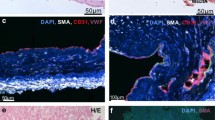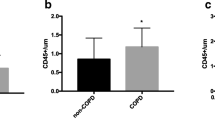Abstract
Cardiovascular disease is the leading cause of morbidity and mortality in patients with moderate-to-severe chronic obstructive pulmonary disease (COPD). More than 44% of these patients present with generalized atherosclerosis at autopsy. It is accepted that endothelial progenitor cells (EPCs) participate in the repair of dysfunctional endothelium and thus protects against atherosclerosis. However, whether COPD affects the repairing capacity of EPCs is unknown. Therefore, the objective of this study was to determine whether and how EPCs are involved in the vascular repair process in patients with COPD. In our study, EPCs from 25 COPD and 16 control patients were isolated by Ficoll density-gradient centrifugation and identified using fluorescence activated cell sorting. Transwell Migratory Assay was performed to determine the number of EPC colony-forming units and the adherent capacity late-EPCs to human umbilical vein endothelial cells. Following arterial damage in NOD/SCID mice, the number of EPCs incorporated at the injured vascular site was determined using a fluorescence microscope. We found that the number of EPC clusters and cell migration, as well as the expression of CXCR4, was significantly decreased in patients with COPD. Additionally, the number of late-EPCs adherent to HUVEC tubules was significantly reduced, and fewer VEGFR2+-staining cells were incorporated into the injured site in COPD patients. Our study demonstrates that EPC capacity of repair was affected in COPD patients, which may contribute to altered vascular endothelium in this patient population.






Similar content being viewed by others
References
Finkelstein J, Cha E, Scharf SM (2009) Chronic obstructive pulmonary disease as an independent risk factor for cardiovascular morbidity. Int J Chron Obstruct Pulmon Dis 4:337–349
Mannino DM, Brown C, Giovino GA (1997) Obstructive lung disease deaths in the United States from 1979 through 1993. An analysis using multiple-cause mortality data. Am J Respir Crit Care Med 156(3 Pt 1):814–818
Zvezdin B et al (2009) A postmortem analysis of major causes of early death in patients hospitalized with COPD exacerbation. Chest 136(2):376–380
Macnee W, Maclay J, McAllister D (2008) Cardiovascular injury and repair in chronic obstructive pulmonary disease. Proc Am Thorac Soc 5(8):824–833
Eickhoff P et al (2008) Determinants of systemic vascular function in patients with stable chronic obstructive pulmonary disease. Am J Respir Crit Care Med 178(12):1211–1218
Barbera JA, Peinado VI, Santos S (2003) Pulmonary hypertension in chronic obstructive pulmonary disease. Eur Respir J 21(5):892–905
Chung KF, Adcock IM (2008) Multifaceted mechanisms in COPD: inflammation, immunity, and tissue repair and destruction. Eur Respir J 31(6):1334–1356
Peichev M et al (2000) Expression of VEGFR-2 and AC133 by circulating human CD34(+) cells identifies a population of functional endothelial precursors. Blood 95(3):952–958
Urbich C, Dimmeler S (2004) Endothelial progenitor cells: characterization and role in vascular biology. Circ Res 95(4):343–353
Zampetaki A, Kirton J, Xu Q (2008) Vascular repair by endothelial progenitor cells. Cardiovasc Res 78(3):413–421
Peinado VI et al (2006) Identification of vascular progenitor cells in pulmonary arteries of patients with chronic obstructive pulmonary disease. Am J Respir Cell Mol Biol 34(3):257–263
Giannotti G, Landmesser U (2007) Endothelial dysfunction as an early sign of atherosclerosis. Herz 32(7):568–572
Aguila HL (2006) Regulation of hematopoietic niches by sympathetic innervation. Bioessays 28(7):687–691
Katayama Y et al (2006) Signals from the sympathetic nervous system regulate hematopoietic stem cell egress from bone marrow. Cell 124(2):407–421
Tepper OM et al (2002) Human endothelial progenitor cells from type II diabetics exhibit impaired proliferation, adhesion, and incorporation into vascular structures. Circulation 106(22):2781–2786
Toshner M et al (2009) Evidence of dysfunction of endothelial progenitors in pulmonary arterial hypertension. Am J Respir Crit Care Med 180(8):780–787
Mukai N et al (2008) A comparison of the tube forming potentials of early and late endothelial progenitor cells. Exp Cell Res 314(3):430–440
Tressel SL et al (2007) Laminar shear inhibits tubule formation and migration of endothelial cells by an angiopoietin-2 dependent mechanism. Arterioscler Thromb Vasc Biol 27(10):2150–2156
Zocchi MR, Poggi A (2004) PECAM-1, apoptosis and CD34+ precursors. Leuk Lymphoma 45(11):2205–2213
Hibbert B et al (2009) Inhibition of endothelial progenitor cell glycogen synthase kinase-3beta results in attenuated neointima formation and enhanced re-endothelialization after arterial injury. Cardiovasc Res 83(1):16–23
Sermsathanasawadi N et al (2009) Enhanced adhesion of early endothelial progenitor cells to radiation-induced senescence-like vascular endothelial cells in vitro. J Radiat Res (Tokyo) 50(5):469–475
Heida NM et al (2010) Effects of obesity and weight loss on the functional properties of early outgrowth endothelial progenitor cells. J Am Coll Cardiol 55(4):357–367
Carbajal KS et al (2010) Migration of engrafted neural stem cells is mediated by CXCL12 signaling through CXCR4 in a viral model of multiple sclerosis. Proc Natl Acad Sci USA 107(24):11068–11073
Petit I, Jin D, Rafii S (2007) The SDF-1-CXCR4 signaling pathway: a molecular hub modulating neo-angiogenesis. Trends Immunol 28(7):299–307
Takahashi T et al (2011) Impaired endothelial progenitor cell mobilization and colony-forming capacity in chronic obstructive pulmonary disease. Respirology 16(4):680–687
Stellos K et al (2008) Platelet-derived stromal cell-derived factor-1 regulates adhesion and promotes differentiation of human CD34+ cells to endothelial progenitor cells. Circulation 117(2):206–215
Newman PJ, Newman DK (2003) Signal transduction pathways mediated by PECAM-1: new roles for an old molecule in platelet and vascular cell biology. Arterioscler Thromb Vasc Biol 23(6):953–964
Hirata Y et al (2010) Diagnosis and treatment of endothelial dysfunction in cardiovascular disease. Int Heart J 51(1):1–6
Pan S (2009) Molecular mechanisms responsible for the atheroprotective effects of laminar shear stress. Antioxid Redox Signal 11(7):1669–1682
Hamed S, Roguin A (2006) Endothelial progenitor cells and atherosclerosis. Harefuah 145(5):358–361, 397
Sitia S et al (2010) From endothelial dysfunction to atherosclerosis. Autoimmun Rev 9(12):830–834
Hill JM et al (2003) Circulating endothelial progenitor cells, vascular function, and cardiovascular risk. N Engl J Med 348(7):593–600
Gehling UM et al (2000) In vitro differentiation of endothelial cells from AC133-positive progenitor cells. Blood 95(10):3106–3112
Sandstedt J et al (2010) C-kit+ CD45− cells found in the adult human heart represent a population of endothelial progenitor cells. Basic Res Cardiol 105(4):545–556
Zhang Y et al (2009) Release of proinflammatory mediators and expression of proinflammatory adhesion molecules by endothelial progenitor cells. Am J Physiol Heart Circ Physiol 296(5):H1675–H1682
Thill M et al (2008) Late outgrowth endothelial progenitor cells in patients with age-related macular degeneration. Invest Ophthalmol Vis Sci 49(6):2696–2708
Timmermans F et al (2007) Endothelial outgrowth cells are not derived from CD133+ cells or CD45+ hematopoietic precursors. Arterioscler Thromb Vasc Biol 27(7):1572–1579
Sata M et al (2000) A mouse model of vascular injury that induces rapid onset of medial cell apoptosis followed by reproducible neointimal hyperplasia. J Mol Cell Cardiol 32(11):2097–2104
Acknowledgments
We thank Dr. Lihua Liu for technical assistance, and Dr. Weiping Tan, Dr. Shuxiang Zhang and the staff of nurses in respiratory department of the First Affiliated Hospital of Sun Yat-sen University for collecting clinical cases, and Prof Zhengyu Dong for the preparation of the manuscript and cover letter.
Conflict of Interest
None.
Author information
Authors and Affiliations
Corresponding author
Additional information
Xiaoran Liu and Canmao Xie authors contributed equally to this work.
Rights and permissions
About this article
Cite this article
Liu, X., Xie, C. Human endothelial progenitor cells isolated from COPD patients are dysfunctional. Mol Cell Biochem 363, 53–63 (2012). https://doi.org/10.1007/s11010-011-1157-y
Received:
Accepted:
Published:
Issue Date:
DOI: https://doi.org/10.1007/s11010-011-1157-y




